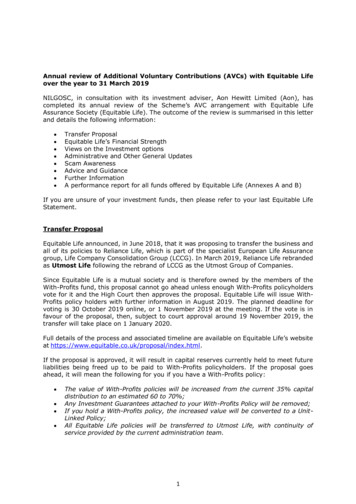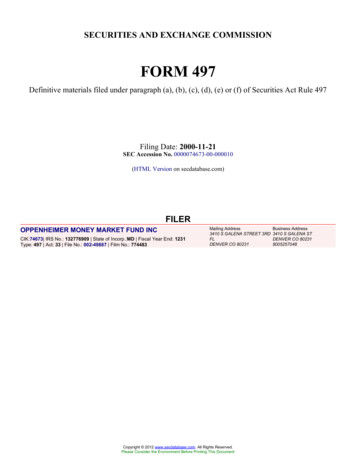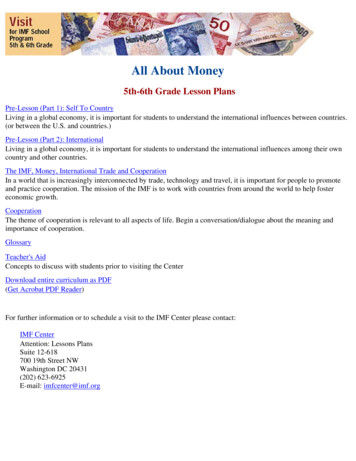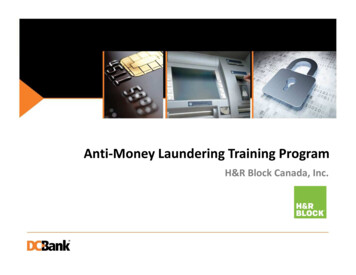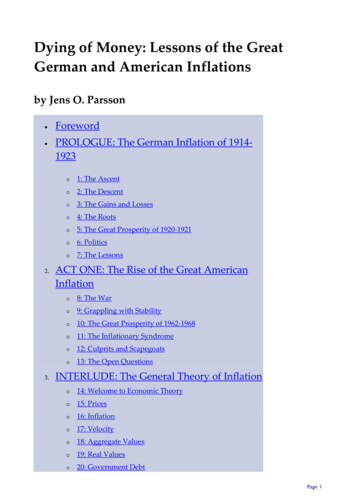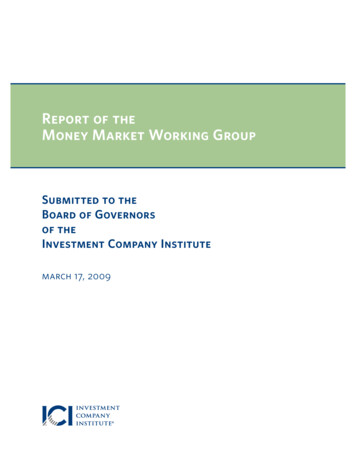
Transcription
Report of theMoney Market Working GroupSubmitted to theBoard of Governorsof theInvestment Company Institutemarch 17, 2009
The Investment Company Institute is the national association of U.S. investment companies, including mutualfunds, closed-end funds, exchange-traded funds (ETFs), and unit investment trusts (UITs). ICI seeks to encourageadherence to high ethical standards, promote public understanding, and otherwise advance the interests of funds,their shareholders, directors, and advisers. Members of ICI manage total assets of 9.88 trillion and serve over93 million shareholders.
To:John V. MurphyChairman, Board of Governors of the Investment Company InstituteFrom:John J. BrennanChairman, Money Market Working GroupDate:March 17, 2009Re:Report of the Money Market Working GroupI am pleased to submit the Report of the Money Market Working Group to the Investment CompanyInstitute’s Board of Governors for its consideration and action. Since the formal establishment of theWorking Group in November 2008, we have conducted a wide-ranging study of the money market, ofmoney market funds and other participants in that market, and of recent market circumstances, thefindings of which are set forth in detail in our Report. Drawing on the difficult experience of the lastyear and a half, we also have developed a series of recommendations designed, among other things, tomake money market funds more resilient in the face of extreme market conditions such as thoseencountered in September 2008.We believe our recommendations respond directly to weaknesses in current money market fundregulation, identify additional reforms that will improve the safety and oversight of money marketfunds, and will position responsible government agencies to oversee the orderly functioning of themoney market more effectively.Many of our recommendations are of a nature that money market funds can and should implementthem immediately on a voluntary basis, pending appropriate rulemaking by the Securities andExchange Commission. Fund complexes represented on the Working Group have signaled theirreadiness to implement these recommendations voluntarily, and we recommend that the Boardapprove them and urge their swift voluntary adoption by all of the Institute’s money market fundmembers. It should be the goal of all money market funds to substantially implement theserecommendations by September 18, 2009, when authorization for the Treasury TemporaryGuarantee Program for Money Market Funds expires. This will provide additional assurance tomoney market fund investors and help facilitate an orderly transition out of the Guarantee Program.i
Report of the Money Market Working Group Our Report also discusses a variety of reforms proposed by others that would fundamentally alter theexisting regulatory or business model of money market funds. We do not believe that such reforms arenecessary or practicable. They also would, we believe, have significant adverse consequences for themoney market at large and for investors in that market.On a personal note, it has been a great pleasure for me to lead this effort. The Board should be aware ofthe remarkable dedication of all the members of and advisers to the Working Group, as well as of theICI staff, that produced the Report.cc:iiBoard of Governors, Investment Company InstitutePaul Schott Stevens
Investment Company InstituteMoney Market Working GroupJohn J. BrennanChairman of the Working GroupChairman of The Vanguard Group, Inc.James H. BodurthaIndependent DirectorBlackRock FundsRichard S. DavisManaging DirectorBlackRock, Inc.Mark R. FettingChairman and CEOLegg Mason, Inc.Martin L. FlanaganPresident and CEOInvesco Ltd.George C. W. GatchPresident and CEOJ.P. Morgan FundsJ.P. Morgan Asset ManagementJohn W. McGonigleVice Chairman and DirectorFederated Investors, Inc.James A. McNamaraPresident and CEOGoldman Sachs Mutual FundsGoldman Sachs Asset ManagementRandall W. MerkExecutive Vice PresidentCharles Schwab & Co., Inc.President of Schwab FundsPaul Schott StevensPresident and CEOInvestment Company InstituteMichael WilensHead of Asset ManagementFidelity Investmentsiii
Advisers to theMoney Market Working GroupMary ColbyDeborah CunninghamManaging Director, Head of Municipal ResearchSenior Vice President, Senior Portfolio ManagerCharles Schwab Investment ManagementFederated Investments, Inc.John T. DonohueDave FishmanChief Investment Officer: Global LiquidityManaging DirectorCo-Head Global Liquidity ManagementJ.P. Morgan Asset ManagementGoldman Sachs Asset ManagementDavid R. GlockeRichard K. HoernerPrincipalManaging DirectorThe Vanguard Group, Inc.BlackRock, Inc.Karen Dunn KelleyKevin KennedyChief Executive OfficerPortfolio ManagerWorldwide Fixed IncomeWestern Asset ManagementInvesco Ltd.ivMary J. MillerCharles MorrisonDirector of Fixed IncomeHead of Fixed Income Money MarketsT. Rowe Price Associates, Inc.Fidelity Investments
Table of ContentsExecutive Summary. 1The Growth of Money Market Funds. 1The Credit Crisis. . 2Recommendations.3Others’ Suggestions for Money Market Reform. 71. Introduction and Methodology . . 91.1 Introduction. 91.2 Methodology. 91.3 Structure of the Report. .102. The U.S. Money Market. 132.1 Structure of the U.S. Money Market. 132.2 Money Market Funds as Financial Intermediaries.183. The Market for Money Market Funds. 213.1 Early Development of Money Market Funds. 213.2 Characteristics of Money Market Funds. . 233.3 Retail Demand for Money Market Funds. . 243.4 Institutional Demand for Money Market Funds. 274. Regulatory Features of Money Market Funds. 314.1 Investment Company Act Protections. . 314.1.1 Oversight and Accountability . 314.1.2 Fund Disclosure. 324.1.3 Custody of Fund Assets . 344.1.4 Prohibitions on Affiliated Transactions . 344.1.5 Limitations on the Fund’s Capital Structure and Its Use of Leverage . 354.1.6 Daily Valuation of Fund Shares . . 354.2 Rule 2a-7 Protections. 364.2.1 Strong Risk-Limiting Provisions. 374.3 Historical Success of Money Market Fund Regulation. 38v
Report of the Money Market Working Group5. Cash Management Alternatives to Money Market Funds. .415.1 Domestic Cash Pools. 425.1.1 Enhanced Cash Funds. 425.1.2 Short-Term Investment Funds and Securities Lending Pools. 425.1.3 Local Government Investment Pools. . 435.2 Overnight Sweep Arrangements . 435.3 Offshore Money Funds. .445.3.1 IMMFA Funds. . 455.3.2 IMMFA Funds’ Neutral Tax Treatment.466. Understanding Money Market Fund Developments in the Financial Crisis. 476.1 Market Events Leading Up to September 15, 2008. 476.2 What Caused Bear Stearns to Fail?.506.3 Primary Fund—Background and Changing Investment Strategy. . 536.4 Market Events—September 2008. . 586.5 Primary Fund—Week of September 15, 2008. 596.6 Events Following September 15-16, 2008.606.6.1 Difficulties Experienced by Pooled Investment Vehicles. . 626.6.2 Government Actions.646.7 Aftermath. 667. Recommendations. 697.1 Portfolio Liquidity Requirements. 727.1.1 Daily Liquidity Requirements . 747.1.2 Weekly Liquidity Requirements. 747.1.3 Stress Testing. . 757.2 Portfolio Maturity. . 767.2.1 Portfolio Maturity Limits That Address Interest Rate Risk. 767.2.2 Portfolio Maturity Limits That Address Spread Risks. . 777.3 Enhance Credit Analysis . 787.3.1 New Products Committee. 797.3.2 Minimal Credit Risks.807.3.3 Credit Ratings Requirement. .817.3.4 Designated NRSROs. 827.4 Assessment of Client Risk. . 827.4.1 Shareholder Due Diligence/Know Your Client Procedures. 837.4.2 Website Disclosure of Client Concentration.84vi
Table of Contents7.5 Addressing the Possibility of a “Run”. . 857.5.1 Authority to Temporarily Suspend Redemptions. 877.5.2 Rule Permitting a Fund to Suspend Redemptions Upon Liquidation.907.6 Investor/Market Confusion About Money Market Funds.917.6.1 Enhanced Risk Disclosure. .917.6.2 Website Disclosure of Monthly Portfolio Holdings. 927.6.3 Anti-Fraud Rule to Address Investor and Market Confusion . 947.7 Government Oversight. 957.7.1 Nonpublic Reporting. . 967.7.2 SEC Staff Surveillance of Certain Money Market Fund Performance. 967.8 Government Resources. 977.8.1 Rule 17a-9 Transactions. 977.9 Government Programs. . 987.9.1 Extension of Treasury Guarantee Program. 987.9.2 Amortized Cost No-Action Letter. 997.10 Forward-Looking Enhancements. . 1007.10.1 Second Tier Securities. . 1007.10.2 Board Oversight. 1018. Others’ Suggestions for Money Market Fund Reform . 1038.1 Floating NAVs and Bank-Like Regulation. . 1048.1.1 Floating NAV . 1058.1.1.1 Reducing Systemic Risk. . 1058.1.1.2 Implications for Investors. . 1078.1.1.3 Alternative Investments and Implications for Markets. . 1118.1.2 Insurance Programs for Money Market Funds. 1128.1.2.1 Pure Federal Insurance. . 1128.1.2.2 Pure Private Insurance. . 1138.1.2.3 Hybrid Insurance Programs. 1148.1.3 Capital Reserves for Funds and Capital Requirements for Advisers. 1148.1.3.1 Capital Reserve for Money Market Funds. . 1158.1.3.2 Capital Requirements for Advisers of Money Market Funds. 1168.2 Other Proposals. 1178.2.1 Separation of Retail and Institutional Investors. 1178.2.2 Redemptions In Kind. 1199. Conclusion. 121vii
Report of the Money Market Working GroupAppendix A:Recommendations of the Money Market Working Group . .123Appendix B:Press Release Announcing Formation of the Money Market Working Group .127Appendix C:Persons Consulted by the Money Market Working Group. . 129Appendix D:Review of States Specifying That Money Market Funds Are Permissible Investments.133Appendix E:History of Rule 2a-7—A Quarter Century of Evolution. . 141Appendix F:History of the Minimal Credit Risk Requirement.167Appendix G:Chronology of Significant Money Market Fund Events and Regulatory Responses.175Appendix H:Survey of Select Offshore Jurisdictions’ Regulation of Money Market Funds. 181Appendix I:Best Practices for Determining Minimal Credit Risks Under Rule 2a-7.193Appendix J:Checklist for Suspending Redemptions and Liquidating a Money Market Fund. 201Appendix K:Treasury Strategies, Inc., Survey of Institutional Cash Managers.205Glossary.213viii
Executive SummaryThe Growth of Money Market FundsMoney market funds,1 which date back to the early 1970s, are one of the most significant financial productinnovations of the past half century. Today, retail and institutional investors alike rely on them as a low-cost,efficient cash management tool that provides a high degree of liquidity, stability in principal value, and a marketbased yield.Money market funds serve as an important source of direct financing for governments, businesses, and financialinstitutions, and of indirect financing for households. Without these funds, financing for all these institutionsand individuals would be more expensive and less efficient.As of year-end 2008, taxable money market funds provided 3 trillion in financing to the taxable moneymarket—or about 25 percent of the total—through their holdings of U.S. Treasury securities, federal agencynotes, commercial paper, certificates of deposit, Eurodollar deposits, and repurchase agreements. Money marketfunds continue to provide an important source of funding in the commercial paper market, holding nearly 40percent of outstanding commercial paper. This market consists of short-term notes issued by a wide variety ofinstitutions such as domestic and foreign nonfinancial corporations, banks, and finance companies that provide,among other things, automobile and credit card financing to U.S. households.State and local governments also rely on tax-exempt money market funds as a significant source of funding forpublic projects such as roads, bridges, airports, water and sewage treatment facilities, hospitals, and low-incomehousing. As of December 2008, tax-exempt money market funds had 491 billion under management and heldan estimated 65 percent of outstanding short-term state and local government debt.Not only are money market funds a financial markets success story, they also are a regulatory success story. Since1983, money market funds have been governed very effectively by the Securities and Exchange Commission(SEC), both as mutual funds generally and pursuant to a carefully crafted rule under the Investment CompanyAct of 1940 (Investment Company Act) that strictly limits the risks these funds can take. Since that rule wasadopted, money market fund assets have grown from about 180 billion to 3.9 trillion as of January 2009.One defining feature of money market funds is that they seek to maintain a stable net asset value (NAV),typically 1.00 per share.2 Retail and institutional investors both highly value the stable 1.00 NAV. Thestable 1.00 NAV provides great convenience and simplicity in terms of its tax, accounting, and recordkeepingtreatment. This simplicity and convenience is crucial to the viability of money market funds because, in contrast1All references to “money market funds” in this Report refer to U.S. money market funds that are registered with the Securitiesand Exchange Commission (SEC) under the Investment Company Act of 1940 and that comply with applicable SEC rules, and, inparticular, Rule 2a-7. A Glossary of certain terms used in this Report is included after the Appendices.2A few money market funds seek to maintain a stable NAV of 10.00 per share. For purposes of simplicity in this Report, we treat allstable NAV funds as funds seeking to maintain a 1.00 NAV per share.1
Report of the Money Market Working Groupwith other mutual funds, they are used primarily as a cash management tool, which means that large numbers oftransactions flow through them each day. Without a stable 1.00 NAV, many, if not most, investors would likelymigrate to other available cash management products that offer a stable 1.00 NAV as investors seek to minimizetax, accounting, and recordkeeping burdens.Money market funds, by law, must comply with stringent maturity, quality, and diversification standards(collectively, “risk-limiting provisions”) designed to minimize the deviation between a money market fund’sstabilized NAV and the market value of its portfolio. These provisions include the requirement that moneymarket funds only invest in high-quality securities, which the fund’s board of directors (or its delegate)determines present minimal credit risks. The basic objective of money market fund regulation is to limit a fund’sexposure to credit risk (risks associated with the creditworthiness of the issuer) and interest rate risk (associatedwith changes in prevailing interest rates).The risk-limiting provisions imposed by the SEC, combined with the other protections of the federal securitieslaws that apply to all mutual funds, have been successful in protecting investors’ interests and maintaining theirconfidence in money market funds. Indeed, until September 2008, only once had a money market fund failed torepay the full principal amount of its shareholders’ investments.A range of other pooled investment products compete with money market funds but are not subject to theInvestment Company Act. Some of these products generally are outside regulatory scrutiny, or may be subject toless stringent regulations than money market funds. Often these products take on more risk, in seeking higheryields, than do money market funds. These alternative products could serve as substitutes for money marketfunds if changes imposed on money market funds make them less desirable to investors.The Credit CrisisThe financial markets are working through the deepest and most pervasive crisis since the Great Depression. Thefundamental causes of this crisis have been attributed to numerous factors, none of which is due to any actionsdirectly taken by money market funds.3 Indeed, the crisis kicked off in earnest more than a year before thefreezing of the credit markets in September 2008, as house prices softened in response to tighter monetary policyand as default rates for subprime mortgage loans began to rise. The crisis spread to commercial banks that hadoriginated these subprime loans and to investment banks that had sponsored or invested in instruments backedby subprime mortgages. It resulted in the failures of some unregistered, short-term investment pools and vehiclesmanaged by state and local governments, prompting investors seeking safety of principal to move 800 billion tomoney market funds from the end of July 2007 through August 2008. It also caused some money market fundadvisers or related persons either to purchase securities that had been issued by structured investment vehicles(SIVs) from, or to enter into credit support arrangements with, their affiliated funds to avoid any losses to fundshareholders. More dramatic effects of the crisis include the failures of Countrywide Financial Corporation; IndyMac Bank, F.S.B.; and a range of other financial institutions, coupled with the government-orchestrated rescue32These factors include: lax lending standards and excessive lending to subprime mortgage markets; development of complexmortgage-backed derivatives; exuberant housing markets; easy credit as a result of a prolonged period of low interest rates early inthe decade; an unchecked model of “originate to distribute” lending; and an abundance of capital from abroad. Myriad reports haveprovided accounts of the causes of the credit crisis. See, e.g., The President’s Working Group on Financial Markets, Policy Statementon Financial Market Developments (March 2008) (“March PWG Statement”); Paul Mizen, “The Credit Crunch of 2007–2008: ADiscussion of the Background, Market Reactions, and Policy Responses,” Federal Reserve Bank of St. Louis Review (September/October 2008) (“The Credit Crunch”).
Executive Summaryof The Bear Stearns Companies Inc. and the government takeover of Fannie Mae and Freddie Mac, all beforethe week of September 15, 2008.Aside from sponsor support, money market funds largely avoided the financial debacle that struck ba
Money market funds,1 which date back to the early 1970s, are one of the most significant financial product innovations of the past half century. . of liquidity, stability in principal value, and a market-based yield. Money market funds serve as an important source of direct financing for governments, businesses, and financial institutions .



